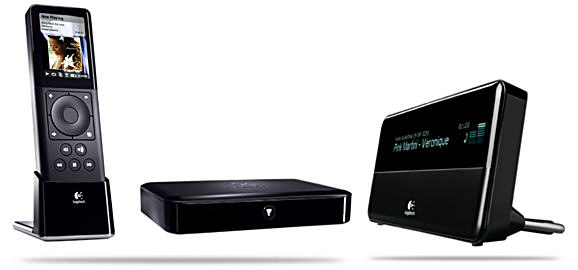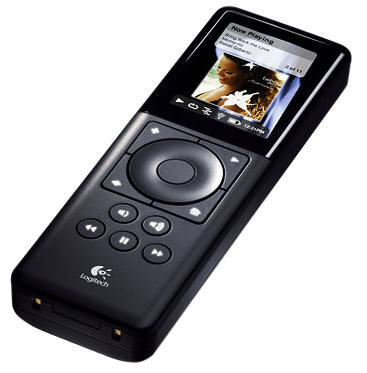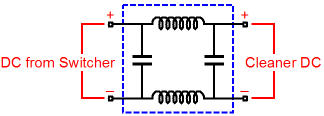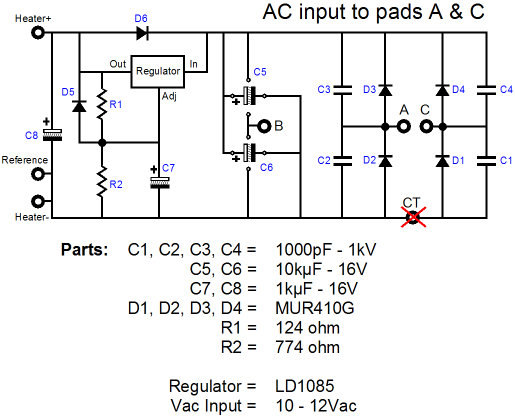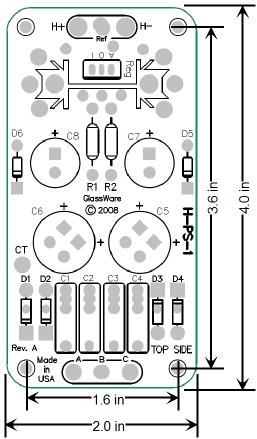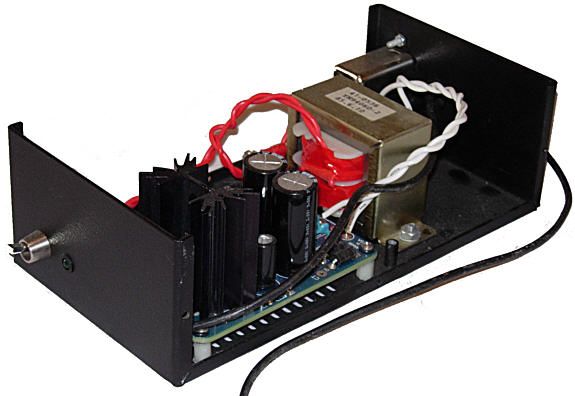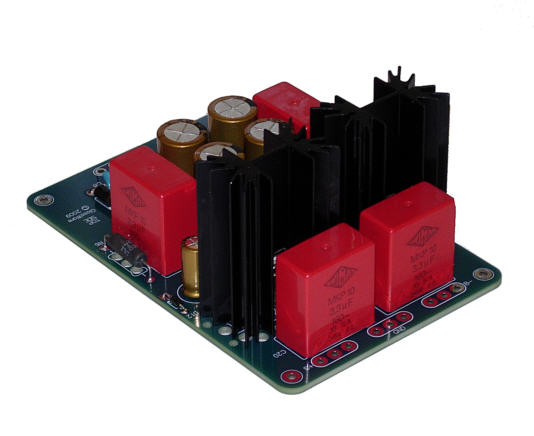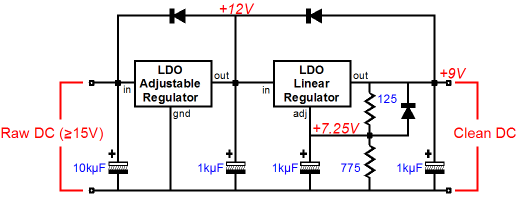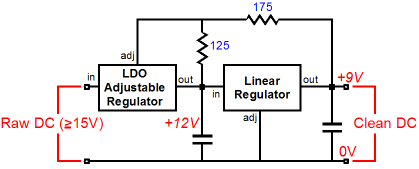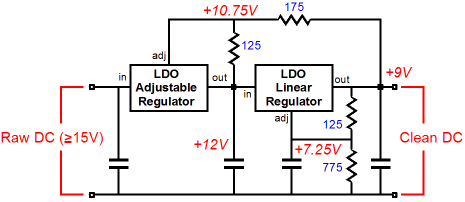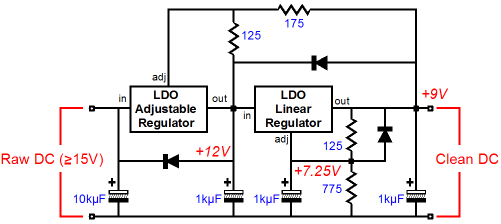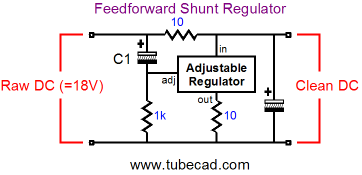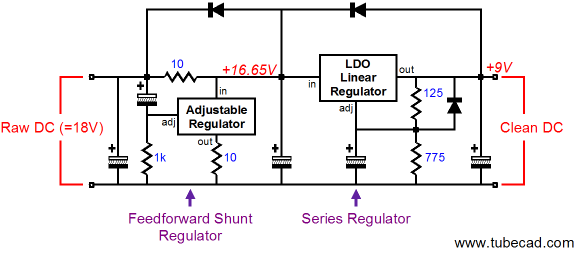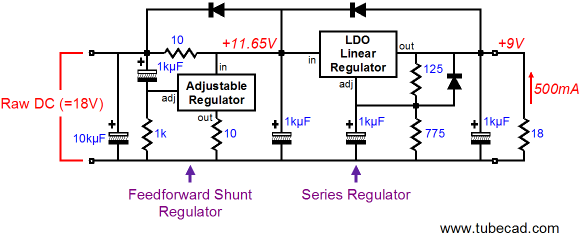| John Broskie's Guide to Tube Circuit Analysis & Design |
6 September 2009
Logitech Duet & Squeezebox
But unlike an MP3 player, the sound coming from your main stereo system is good, quite good. Both Logitech players use high-quality DACs and all my albums have been ripped to the hard drive in WMA-lossless format. The new Duet receiver box improves on the old Squeezebox’s sound (and sounds even better when digitally connected to my Cambridge Audio DacMagic). Unfortunately, the Duet receiver box uses obscure security screws to lock away its internals, so getting its plastic box open is not easy.
This means that for most solder slingers, all the modifications to the Duet must be external. In other words, the external Duet external power supply is about the only easily upgradeable portion. Out of the box, the Duet comes with a small 9Vdc/0.5A switcher wallwart power supply. I haven’t measured the noise at its output, but I bet it’s something close to 100mV, which would not be too bad for a switcher, as many are burdened with 250mV worth of noise. What to do?
Logitech Duet Power Supply Upgrade
The active alternative is to build a better voltage regulator. But what type of regulator? Another switcher? This is not as silly a question as it might seem, as buck-switching power supplies can prove surprisingly low in noise, as its output inductor smooths away much of the harsh harmonics. Nevertheless, the most obvious and easiest choice is a high-quality linear voltage regulator. There is a good reason why Logitech players (and just about all new electronic devices) ship with little switching regulators. Linear regulators are big, heavy, inefficient, and wonderfully quiet. Because designing a complex, discrete, solid-state voltage regulator can prove such a daunting task, most electrical engineers design around three-pin voltage regulators. These little marvels are robust, simple to use, and dirt cheap. Three-pin, fixed-voltage regulators are the easiest to use, but you must pay a noise penalty. Adjustable three-pin regulators, such as the LM317, LM350, LT1084, and LD1085 require a bit more design time and extra parts, but they offer substantially better performance.
I have made for my Duet two (or is it three?) 9V regulators out my H-PS-1 regulator kits. (I have made the mistake of letting friends borrow my 9V wonders and they get glued to the other system.) The H-PS-1 only takes one resistor value change to change its output voltage to 5V or 9V. The ultra-fast rectifiers, high-frequency capacitors, and quality voltage regulator all add up to a nice linear regulator.
Now, if I had any business sense, I would shut up right here; instead, I will boldly go onto other circuits. So how do we further hotrod this basic circuit? We could start designing that scary, complex, discrete, solid-state voltage regulator…Or we could add a passive RC-filter to a linear regulator’s input, which would help scrub away much of the rectifier hash. All that is needed is a large, low-valued power resistor and a large-valued smoothing capacitor.
This is the approach that I used in my low-voltage bipolar power supply kit and it works quite well. For example if you use a 10kµF capacitor and a 10-ohm power resistor, the low-pass corner frequency is a low 1.6Hz, which means that the 100Hz/120Hz rectification harmonic is at least six octaves away and at least -30dB down in magnitude.
The downside to the power resistor is heat and lost voltage. On the other hand, an ideal inductor displaces zero voltage, so it dissipates zero heat. Thus, an ideal inductor would drop no voltage or dissipate any heat. Real inductors, on the other hand, do hold DCR that will displace voltage and will heat up. Still, a low-DCR inductor might make a good compromise. In addition, an LC low-pass filter attenuates at -12dB per octave in contrast to the RC filter’s -6dB per octave slope. In other words, a 1.6Hz low-pass filter will be down at least -60dB at the 100Hz/120Hz rectification harmonic. By the way, tube-power-supply chokes are not a good choice here, in spite of their huge inductance, because of their high DCR; I own a few chokes with a DCR of 1kohm, for example. In fact, an air-core choke might prove the best choice, as the air-core will melt before it saturates. (If you are like me, you probably have a bin filled with crossover parts from failed or aborted loudspeaker projects.)
Cascaded Regulators One possible arrangement would be to use a switching power supply as the pre-regulator, which would give us many of the advantages of switching regulators, such as a hugely wide AC input voltage range, say from 90Vac to 260Vac; very little extra weight, as the switching power supplies do not use big power transformers; and a modest expenditure of cash, as switching power supplies are shockingly cheap.
On the other hand, a DC-to-DC switching regulator could be used instead of an AC-to-DC switching regulator. Imagine a beefy wallwart or a toroidal power transformer powering a rectifier bridge and big power supply capacitors and then cascading into an AC-to-DC switching regulator and then a linear regulator.
The problem with this approach might be that the linear regulator, which has limited open-loop bandwidth and which has been optimized to deal with low-frequency rectifier noise, may not be as effective at scrubbing away the switcher’s high frequency hash. Thus, an RC or LC pre-filter might be needed between switching regulator and linear regulator. The more obvious pairing is two linear regulators cascading. Two fixed regulators could easily be assembled, with a 12V regulator feeding a 9V regulator. I would be keen to know how well this worked compared to the single adjustable voltage regulator.
One potential problem here is that, as far as I know, no one makes a really fine 9V fixed voltage regulator. On the other hand, there are several excellent low-dropout (LDO) fixed 12V linear regulators on the market.
Below is the same topology, but fleshed out a bit more.
Tracking Pre-Regulators
Or an adjustable pre-regulator can be used.
To be frank, the above two circuits little benefit from input regulators tracking the output fixed regulator’s output, as the fixed 9V linear regulator does not exhibit a slow turn on or can have its output voltage changed; it is a fixed regulator after all. In contrast, a tracking pre-regulator works well with an adjustable output regulator.
Below is the same topology, but with more details added.
Low-Voltage Feedforward Shunt Regulators
Capacitor C1 relays the ripple to the regulator’s adjustment pin, which causes the 10-ohm resistor at the regulator’s output to see all of the ripple across its leads. In turn, the current variations induced by the ripple across this resistor will be transmitted through the regulator to its input pin, which meets its own 10-ohm resistor in series with the incoming raw DC voltage. The series resistor then develops a varying voltage across its leads due to the varying current created by the ripple voltage across the other 10-ohm resistor. The result is that the series resistor effectively counters all the ripple, leaving only clean DC voltage at the feedforward-shunt regulator’s output. Magic. The feedforward-shunt regulator’s output impedance ____ no lower than the series resistor’s value and its DC voltage is not fixed; thus, a second series regulator is required.
The above voltages are only valid for an unloaded regulator. Under a 500mA load, the following voltage are realized.
Now a 5-volt voltage drop across the series resistor seems a high price to pay for the feedforward-shunt regulator ripple scrubbing, but my guess is that the Duet does not draw anything close to 500mA, so the voltage drop could prove to be much smaller. I have yet to test this circuit and I present it here only as a thought experiment. On the other hand, if I can figure out a way to hack one of my low-voltage regulator PCBs, I would be eager to give this design a test drive. Speaking of test drives...
Cash for Clunkers In other words, I cannot expect every reader to have heard about the US government’s bold, new initiative: CARS, the Car Allowance Rebate System, aka "Cash for Clunkers." The plan was simple: trade in your old car for a new car and the government (the taxpayers) will write a check for $4500 to the new car dealer on your behalf. Obviously, only cars worth less than $4500 would be traded in; and government restrictions apply, for example the new car must get better milage than the old car. Amazingly, there was no Buy-American clause and, in fact, most cars (80%) bought were Japanese brands. Since old cars can be a pain, polluting, unsafe, and downright ugly, who could complain? Well, I suppose all the makers of high-end audio gear along with all the other producers of big-ticket items, such boats, appliances, facelifts… could argue that they too could benefit from a government kickback system and that by giving car manufactures a break means that they get hurt, as the money being directed to car purchases cannot now be spent on their goods; few can be expected to buy a new car and a new boat and new swimming pool... The charities that rely on old car donations cannot be too happy. Nor will the rest of us necessarily be thrilled, meaning those who haven’t bought a new car may not like having to pick up the tab for the program from our taxes. Even some car dealers are grumbling, as they complain of having to deal with a bureaucratic nightmare and having not yet receiving their promised checks. But such whining is a constant and, thus, easily ignored, besides it misses the big picture: the US government has rediscovered a vitally powerful practice: the economic equivalent to therapeutic phlebotomy, bloodletting for medical benefit. Up until two hundred years ago bloodletting was all the rage. The ancient Mesopotamians, Egyptians, Greeks, and Mayans knew of its salutary effects. Even Hippocrates understood that menstruation purged bad humors from a women’s body and saw that there was no reason that men couldn’t also share in this joy. And although accidents, war, knife fights, and attacks by savage animals did contribute towards this noble goal, more help was needed, help that doctors provided across the world. They did not work alone; not too long ago barbers did more than just cut hair and leeches were as popular as hamsters are today. Sadly, bloodletting, like so many time-honored practices such as sati are no longer honored let alone practiced, except by the wealthy and politically powerful. But the principle of destroying wealth to preserve and augment wealth is certainly sound; as leading government economists have argued, subtraction is addition. As so often is the case, the US government is leading the way for the rest of the world. For example, it has boldly fought not against, but for monetary inflation, secure in the perfect knowledge that by definition all inflation must destroy some of a currency’s value. The love of money may or may not be the root of all evil, but the understanding of the role played by money is certainly the cause of many yawns and much boredom. Few have the patience, let alone the desire, to grapple with monetary theory. (What is the point of having the smartest people in the room, such as Timothy Geitner and Henry Paulson, if not to have them take care of the boring details and send us the bill at the end of the month?) But here is where the Cash for Clunkers program truly shines as a sterling example of the genius behind the destruction of valuable assets, an example that even the dullest child can readily understand. When an old car is traded in for a new car, the old is not then sold to someone else, nor is it sold to an auto wrecker to be disassembled and sold as many discrete used parts, nor is given to needy people in third-world counties. It is destroyed; well at least its engine is, as it will be filled with sodium silicate. Indeed, with the Cash for Clunkers program, the US government has compelled the destruction of valuable assets in order to create even more wealth; what do you think all those new cars are? How could you have new good cars while old bad cars existed? I can imagine that many are just not getting it. Recall that during the great depression, the US government ordered and supervised the pouring of fresh milk into sewers, the slaughtering of thousands of pigs not to be eaten, and burying of fields of grain to help the economy recover. Of course, some Neanderthal types claim that such destruction was immoral when many where destitute and hungry. But these critics would likely bemoan the letting of a sick man’s blood, not realizing that when he is sick, injured, and nearest to death is precisely when the bloodletting is needed most. In fact, some of these same Neanderthal types go so far as to proclaim that the FDR’s New Deal didn’t end the Great Depression, but painfully prolonged it; that what ended the depression was the end of FDR. Do they not realize that all the previous economic recessions that America suffered through up to the Great Depression lasted two years and the Great Depression was over, due to FDR’s leadership, in just-- Wait--I am sure many readers are thinking, "Just what the heck does this have to do with vacuum tubes?"
To paraphrase the Bard himself, I looked upon myself and cursed my fate, wishing me like to one more rich in money, featured like any of the Baldwin brothers, like Cameron Diaz with famous friends possessed, desiring Courtney Arquette’s art and Aaron Eckhart's scope, with what I most enjoy contented least, yet in these thoughts myself almost despising, happily I thought on our dear leader… And then it hit me: "Clunkers for Glass." Old cars are not ecologically forgivable. They sin egregiously. But they are not alone. Tube amplifiers also sin; they transgress shamefully, opulently, dissipating heat wildly, heat that raises the seas and scorches the rainforests. Could not the US government give us checks for trading in our old Dynaco, Marantz, McIntosh, Quad tube power amplifiers for small, efficient, class-D power amplifiers… Well as soon as the nausea passes, you, too, will be eager to pledge to getting rid of all these wicked threats against a future green paradise.
//JRB |
Kit User Guide PDFs
E-mail from GlassWare Customers And
High-quality, double-sided, extra thick, 2-oz traces, plated-through holes, dual sets of resistor pads and pads for two coupling capacitors. Stereo and mono, octal and 9-pin printed circuit boards available.
Designed by John Broskie & Made in USA Aikido PCBs for as little as $24 http://glass-ware.stores.yahoo.net/
The Tube CAD Journal's first companion program, TCJ Filter Design lets you design a filter or crossover (passive, OpAmp or tube) without having to check out thick textbooks from the library and without having to breakout the scientific calculator. This program's goal is to provide a quick and easy display not only of the frequency response, but also of the resistor and capacitor values for a passive and active filters and crossovers. TCJ Filter Design is easy to use, but not lightweight, holding over 60 different filter topologies and up to four filter alignments: While the program’s main concern is active filters, solid-state and tube, it also does passive filters. In fact, it can be used to calculate passive crossovers for use with speakers by entering 8 ohms as the terminating resistance. Click on the image below to see the full screen capture. Tube crossovers are a major part of this program; both buffered and un-buffered tube based filters along with mono-polar and bipolar power supply topologies are covered. Available on a CD-ROM and a downloadable version (4 Megabytes). Download or CD ROM
|
|||
| www.tubecad.com Copyright © 1999-2009 GlassWare All Rights Reserved |
